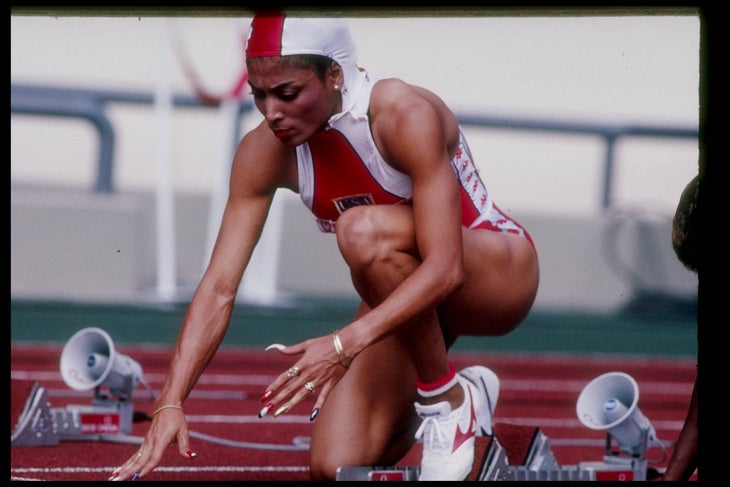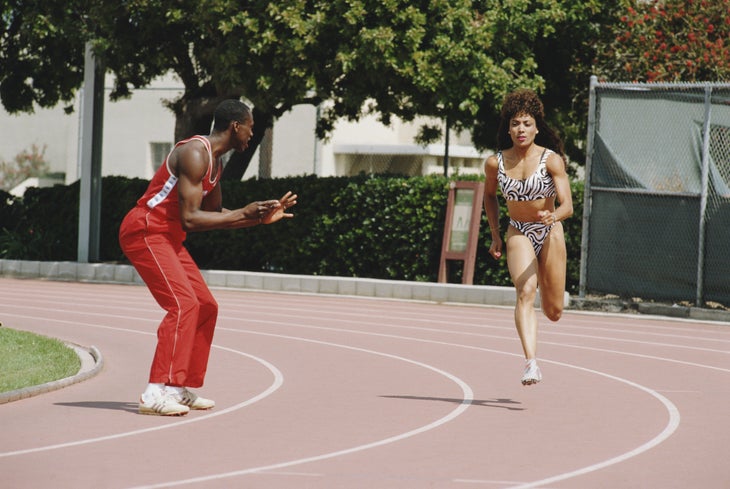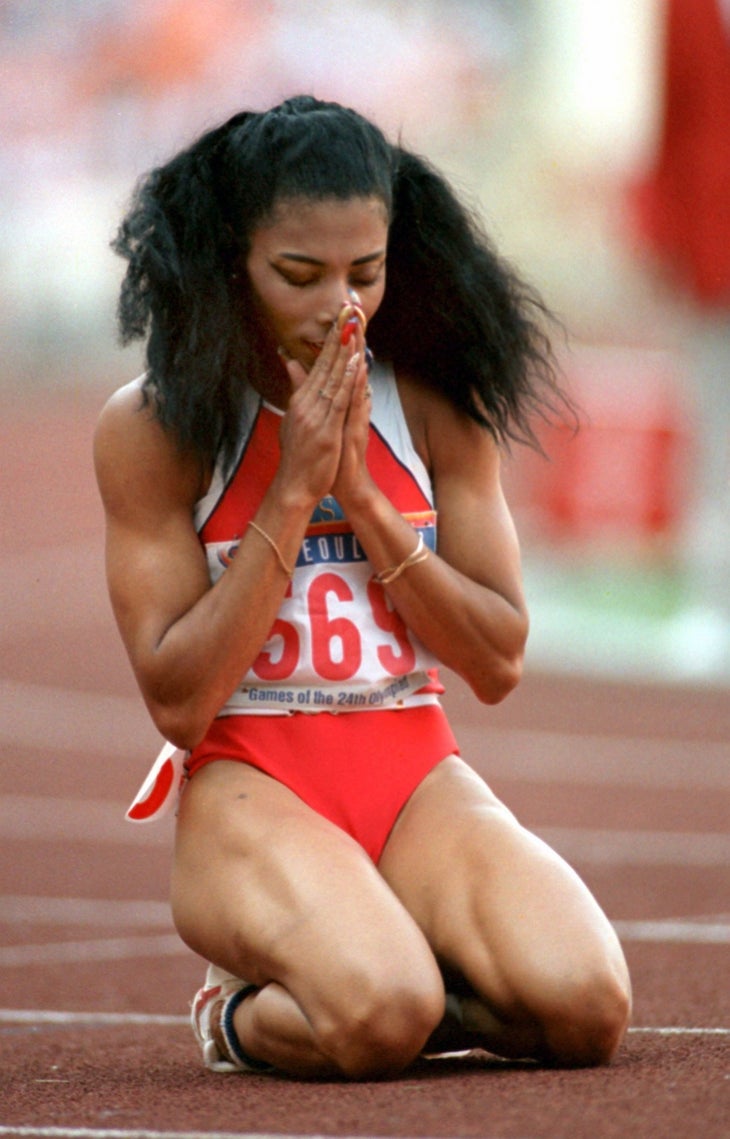New perk! Get after it with local recommendations just for you. Discover nearby events, routes out your door, and hidden gems when you sign up for the Local Running Drop.
For one glorious, perfect season in 1988, Florence Griffith Joyner — better known as “Flo-Jo” — did things on the track that no woman had ever done before nor has managed to replicate since. The fastest woman on the planet set world record times of 10.49 for the 100 meters and 21.34 for the 200 meters that still stand today, and she did it in style — sporting six and a half inch acrylic nails, long, flowing hair, a full face of makeup and self-designed race kits with asymmetrical, one-legged bodysuits, lace detailing and color-blocked bikini bottoms.
“Dress good to look good. Look good to feel good. And feel good to run fast!” she said of her on-the-track fashion statements.
That sentiment has inspired an entire generation of athletes, who are still chasing her winning combo of record-setting performances and trendsetting style. This year, two women have gotten closer to Flo-Jo’s marks than ever before: Jamaica’s six-time global 100-meter champion Shelly-Ann Fraser-Pryce, who clocked a wind-legal 10.63 in June, and the United States’ Gabby Thomas, who won the U.S. Olympic Trials 200 meters in 21.61. Both Fraser-Pryce and Thomas are now the second-fastest women in world history.
RELATED: Gabby Thomas Makes Olympic Team, Becoming Second-Fastest Woman Ever at 200 Meters
While a new world record in either event would send massive shockwaves through the running community, anything seems possible at the pandemic-postponed Tokyo Olympic Games. As the fastest women in the world take their place on the track in Tokyo, here’s everything you need to know about the late track great who’s ruled the record books for the past 33 years.

Humble Beginnings
Florence Delorez Griffith (“Dee Dee” to her friends and family) was born in Los Angeles on December 21, 1959, the seventh of 11 children to Florence, a seamstress, and Robert Griffith, an electrician. The couple divorced when the future track star was six years old, and her mother moved the children to the Jordan Downs housing project in the rough Watts section of L.A.
From a young age, Griffith Joyner developed an interest in sports and fashion. In interviews, she said the two go hand in hand. If she wanted to play sports outside with her brothers, she had to make sure her hair and outfit looked presentable.
“My brothers… they made me very competitive because they would knock me down and I couldn’t cry,” she said in an interview with Ann Liguori. “If I cried, I wasn’t allowed to continue to play with them, so they helped me as far as my competitive edge is concerned. And in the world of fashion, because they didn’t want me to look like a boy and be out there playing.”
She started experimenting with sewing her own clothes from the age of seven, and joined the Sugar Ray Robinson Youth Foundation, where she played basketball, volleyball, football and ran track for the first time. Her natural talent was clear; she won the Jesse Owens National Youth Games two years in a row as a 14- and 15-year-old, and at Jordan High School in L.A., she set school records in the long jump and the sprints. Always with the eye for flair, part of the Flo-Jo legend is that she convinced her high school relay teammates to pair long tights with their track uniforms.
She wasn’t a superstar just yet — her best finish was sixth place at the CIF state meet as a senior — but she caught the eye of Cal State Northridge coach Bob Kersee, who would change her life.

Learning How to Win
Griffith Joyner graduated from high school in 1978 and briefly attended Cal State Northridge, where she was part of Kersee’s national title-winning track program. Despite her success on the track, she dropped out of school the following year for financial reasons and worked as a bank teller to earn money for her family.
By 1980, Kersee had moved on to an assistant coaching position at UCLA, where he was able to help Griffith Joyner secure financial aid. She nearly made her first Olympic team that year, which were ultimately boycotted by the United States, when she placed fourth in the 200-meter final at 20 years old.
The 1980 Olympic Trials were also where she first met her future husband, triple jumper Al Joyner, who would go on to win the Olympic gold medal in 1984.

Back at UCLA, Griffith Joyner trained with Al’s sister, Jackie Joyner-Kersee, who later became one of the winningest track and field athletes of all time in addition to marrying their coach, Bob Kersee. Her world record in the heptathlon still stands today. The Griffith-Joyner-Kersee clan is one of the greatest sporting families in U.S. history.
While Al pined from afar (he competed for Arkansas State), Griffith Joyner learned what it meant to win at the highest level. She won the 1982 NCAA title in the 200 meters in 22.39, and the 1983 NCAA title in the 400 meters in 50.94, as UCLA won back-to-back national team titles. She graduated from UCLA with a degree in psychology and placed fourth in the 200m at the World Championships that summer.
In 1984, Griffith Joyner made her first Olympic team and earned a silver medal in the 200 meters in front of her hometown crowd in Los Angeles.
But despite her status as an Olympic medalist, track and field was still shaking off the shackles of amateurism and had not yet transformed into the professionalized sport of today. In other words, the financial support wasn’t there for Griffith Joyner to focus solely on training. So, she didn’t — instead, she went into “semi-retirement” and worked as a bank teller and beautician. She often stayed up late at night doing her friend’s nails and hair — charging between $45 and $200 for the intricate braids.
In 1987, Griffith Joyner started training seriously again and won another silver medal in the 200 meters, this time at the World Championships. That October, she officially joined the “first family of track and field” when she married Al Joyner.

The Magic Year — and Controversy
While Kersee remained Griffith Joyner’s official coach through the 1988 Olympic Trials, Al gradually took on a larger role in overseeing her preparations. Inspired by Ben Johnson’s powerful start out of the blocks at the 1987 World Championships, they incorporated more weight training into her routine — according to ESPN, she was able to squat 320 pounds while weighing 130 pounds. They worked out at 4 a.m. She watched her diet and cut back on the late-night home nail salon sessions.
“To run like a man, you have to train like a man,” she said of her more muscular physique.
When Flo-Jo beat Al in a race, they knew she was ready to run fast. But even Al didn’t know exactly how fast that would be.
At the U.S Olympic Trials in Indianapolis on July 16, 1988, outfitted in a custom adidas “one-legger” purple speedsuit with a turquoise patterned bikini bottom, Griffith Joyner let out the fireworks in the quarterfinal round of the 100 meters, demolishing the field and setting a new world record of 10.49. The time was almost three tenths of a second faster than the old world record of 10.76 — so fast, that even the on-air broadcasters assumed it was an error.
“No one can run that fast. The heat must be doing something to the electronics,” ABC announcer Marty Liquori said.
With an official wind reading of 0.0, the time would count as a world record. But even now, controversy remains about whether or not that was a faulty reading on a day that produced plenty of wind-aided marks. Omega Timing conducted an investigation of the wind-gauge and timing system after the event and found no malfunction, but many track and field statisticians still do not recognize the mark as legal.
Griffith Joyner ultimately won the 100-meter final in 10.61, the second-fastest time in world history (and universally recognized as wind-legal), as well as the 200-meter final in 21.85, an American record.
The next week, she left Kersee’s camp to be trained full-time by Al and hired a new business manager. Things were about to get big.

Now in full Flo-Jo mode, Griffith Joyner was the darling of the Seoul Olympic Games, claiming three gold medals in the 100 meters, 200 meters and 4×100-meter relay. Her winning time of 21.34 in the 200m set another world record by an incredible margin. Then, she ran a last-minute anchor leg for the Americans on the 4×400-meter relay, and though she couldn’t upset the East Germans, her 48.08 split was the fastest in U.S. history at the time.
It was an incredible performance. But a shadow was soon cast over her performances when men’s 100m Olympic champion Ben Johnson of Canada tested positive for steroids. Later, Griffith Joyner’s former UCLA teammate Darrell Robinson claimed that he had sold the sprint star steroids himself. It was later reported that Robinson had been paid $25,000 for the story, which was published in a West German magazine. Robinson was ostracized from the track community.
Through all the rumors, Griffith Joyner never failed a drug test.
“At first, when she beat the record, they said it was wind assisted,” Al said to CNN. “Later when she won the medals they said it was drugs.”
NBC Olympic broadcaster Ato Boldon, himself a four-time Olympic medalist, dismisses any allegations of steroid use by his former UCLA teammate. However, he does believe that her 100-meter world record was wind-aided.
“I have talked to people who were in the race, I have talked to more than 20 people who were at that meet at that stadium and not one of them think that that race was not wind-aided,” he says. “The evidence for that race being wind-aided is that there’s jumps going on at the same time and every one of those jumps has pretty significant wind… You know how rare it is to get a wind gauge to read 0.0? The more time you spend in this sport, you know the wind is always going some way or another.”

Tragedy for the Joyners
In February of 1989, just five months removed from her record-breaking Olympic run, Griffith Joyner announced her sudden retirement from the sport. Critics said she was dodging drug testing. She said that she couldn’t maintain her fitness with the constant travel required of the financial opportunities around her newfound fame. Al later revealed that they were already trying to start a family.
Their daughter, Mary, was born in November of 1990.
Proclamations of a comeback came soon after. Some (running a marathon in 2:18), were more outrageous than others (winning gold in the 400m), but an Achilles tendon injury kept her out of contention for the 1996 Olympic Games in Atlanta.
Just two years later, she tragically died in her sleep at 38 years old.
The cause of death was an epileptic seizure brought on by a congenital abnormality in her brain. She had a seizure while sleeping facedown on her bed, and she suffocated. She had suffered from a seizure on a flight in 1996.
The autopsy found no signs of steroid use.

Florence Griffith Joyner’s Legacy Lives on
”We were dazzled by her speed, humbled by her talent and captivated by her style,” President Bill Clinton said of the icon upon her shocking death in 1998.
That Clinton had actually shared a few miles with Griffith Joyner around the National Mall speaks to her influence in popular culture beyond track and field.
Clinton named her co-chairwoman of the President’s Council on Physical Fitness and Sports in the early ‘90s. She worked with inner-city children through her Flo-Jo International Foundation. She figured out how to cash in when track and field was still pulling the cobwebs off its amateurism rules. She commanded thousands of dollars in appearance fees. She designed two separate fashion lines in Japan. Later, after her retirement, she designed uniforms for the NBA’s Indianapolis Pacers. She wrote children’s books. She made guest appearances on TV sitcoms. She had contracts with Coca-Cola and Mitsubishi. She had a Flo-Jo Barbie doll, complete with its own “one-legger” speedsuit.
“Track and field is a beautiful sport and I just wanted to bring it my personality and the clothes that I wear off the track on to the track, just to be myself,” she said in a 1992 interview with Ann Liguori, “and fashion designing has been my life since I was a young child.”
She was the first big box office star in track and field, before anyone ever heard of Usain Bolt, and she is the first woman referenced whenever a bright new female talent emerges.
Some sprinters name-check Flo-Jo themselves, explicitly naming her as an inspiration, while others channel her style in the ‘look good, feel good’ energy they bring to the track.
“The legacy of Flo-Jo is very strong because I see it literally on the faces of every track and field athlete now,” Boldon says. “No one was competing in nails and fancy uniforms and face full of makeup and hair. That wasn’t happening. Flo-Jo decided that was going to be her signature… They all have their influence from Flo-Jo.”
And what would she think if she could see today’s stars? “She would be in the stands now smiling,” Boldon says.
RELATED: How Women’s Track and Field Fought Their Way Into the Olympics—by Staging Their Own